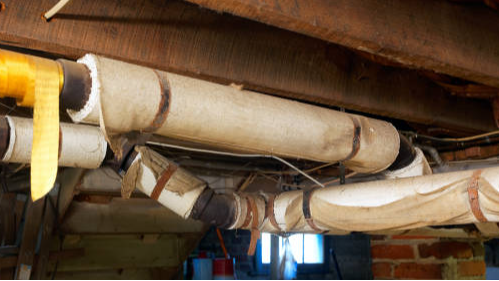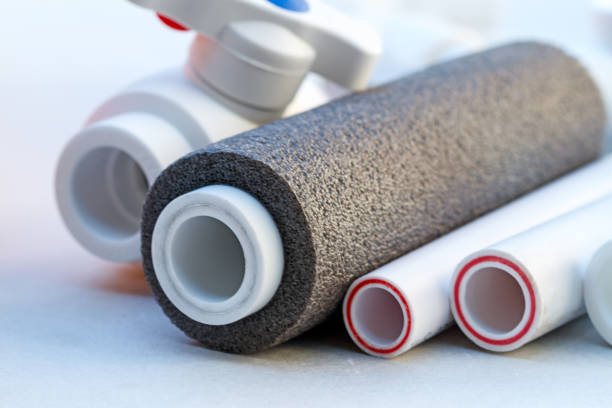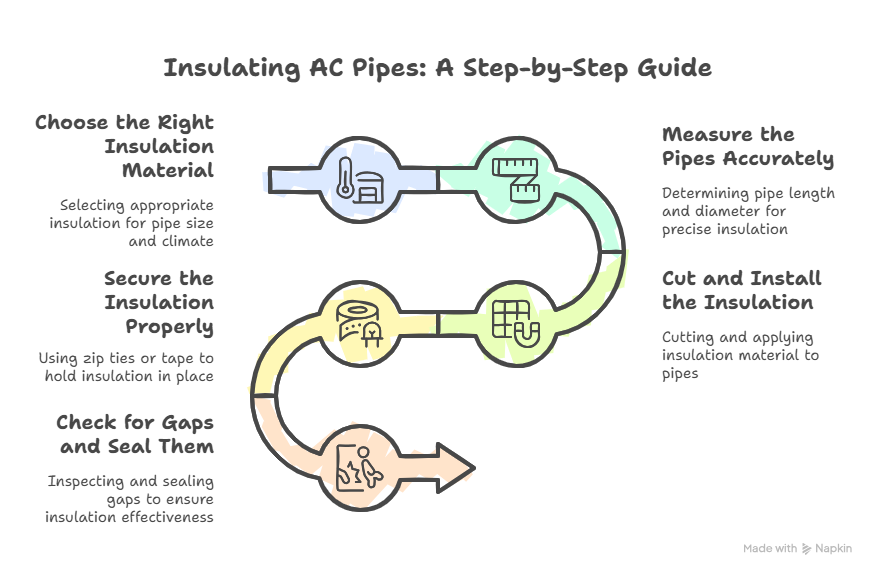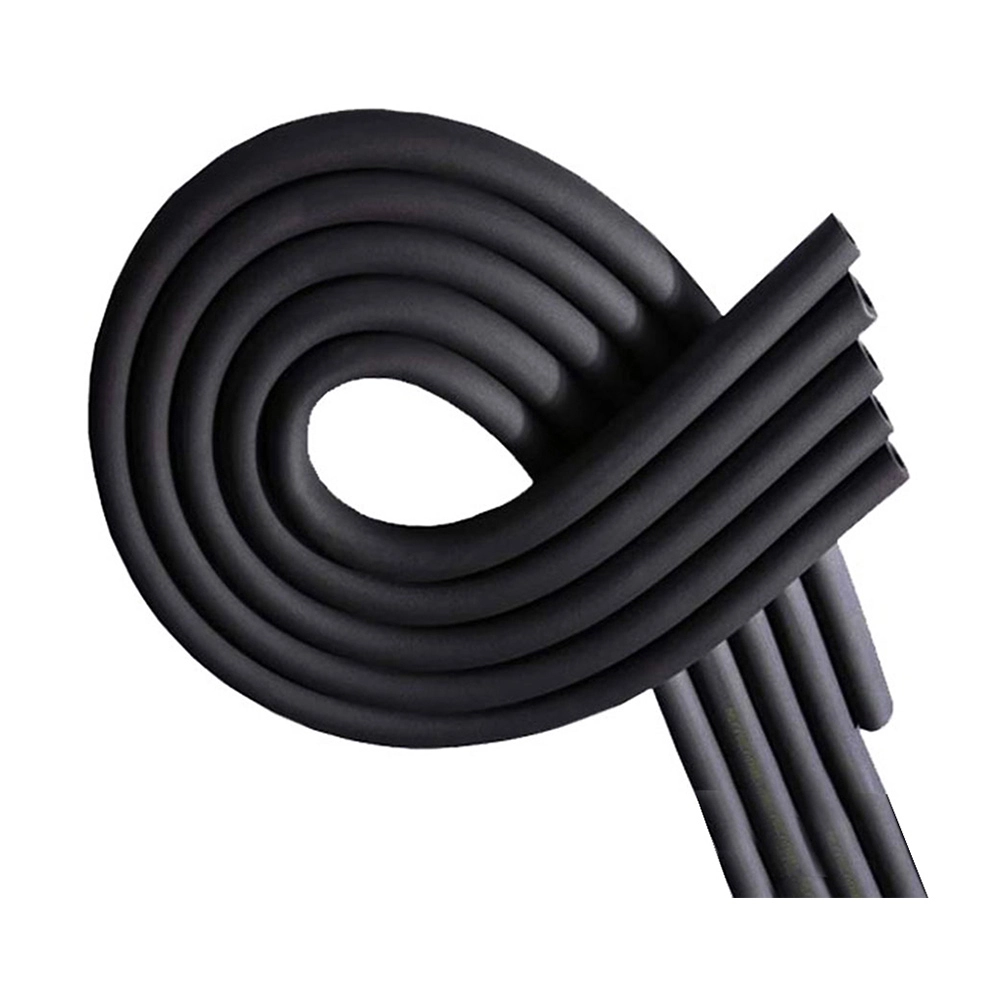Preface
Properly insulating your AC pipes can save energy, prevent condensation, and extend your system’s lifespan. Whether you're a homeowner trying to lower your energy bills or a professional working on HVAC maintenance, this
guide will walk you through
how to insulate AC pipes step by step.
We’ll explore the best insulation materials, explain why insulation matters, and offer practical advice to help you get the job done correctly and safely. From choosing the right tools to avoiding common mistakes, everything you need is here. By the end of this guide, you’ll be fully equipped to take care of your AC pipe insulation with confidence and precision.
Why Insulating AC Pipes is Important
Insulating your AC pipes might not be the most glamorous part of home maintenance, but it plays a crucial role in the performance and efficiency of your air conditioning system. When pipes are left uninsulated or poorly insulated, they can become a source of energy loss. This happens because the refrigerant inside the pipes is affected by the outside temperature, making the system work harder to maintain the desired indoor climate. Over time, this extra effort not only increases your energy bills but also puts more strain on your AC unit, shortening its lifespan.
In addition to energy efficiency, insulation helps prevent condensation. Especially in humid environments, cold pipes can cause moisture in the air to condense on their surface, leading to dripping, corrosion, and even mold growth if left unchecked. By insulating your AC pipes, you create a barrier that stabilizes the surface temperature of the pipes, stopping condensation in its tracks. Simply put, good insulation means less maintenance, better performance, and a longer-lasting system. If you’re investing in your home comfort, this is one area you don’t want to overlook.
Types of AC Pipe Insulation Materials
When it comes to choosing the best insulation for AC pipes, the material you use matters. Each type has its pros and cons, and the right choice often depends on your climate, budget, and long-term needs. Below are the most common options used in residential and commercial AC systems.
Foam tubes are one of the most accessible and affordable types of insulation. Made from flexible polyethylene or elastomeric foam, these sleeves are lightweight and easy to install. They come pre-slit for convenience, so you can simply wrap them around the pipe and secure them. While foam tube insulation offers decent thermal resistance, it doesn’t perform well in very hot or cold environments. Over time, UV rays and extreme temperatures can cause them to degrade. Still, for moderate climates and indoor applications, they offer a cost-effective solution.
Rubber insulation is more durable and flexible than standard foam. It handles temperature fluctuations better and resists UV damage, making it suitable for both indoor and outdoor use. Rubber also has excellent moisture resistance, which helps reduce the chance of mold or mildew forming around your pipes. Although slightly more expensive, it’s a reliable long-term option. For those looking for high-quality rubber insulation that performs well in demanding environments, Funas offers excellent options known for both durability and energy efficiency.
Fiberglass insulation isn’t just for attics and walls—it’s also great for large or commercial AC systems. It consists of thick fiberglass wrap and often includes a vapor barrier to prevent condensation. It performs exceptionally well in extreme heat or cold and is resistant to fire. The downside? It’s more complex to install and requires careful handling due to the tiny fibers that can irritate your skin and lungs. Still, for larger jobs or long runs of pipe, it’s hard to beat. Funas also supplies premium-grade fiberglass insulation, designed to meet professional standards and deliver top-tier performance.
This is another foam-based option, slightly more rigid than rubber but still relatively easy to install. Polyethylene foam offers good insulation for shorter pipe runs or applications where flexibility is less of a concern. It’s lightweight and non-toxic, often used in household systems. However, it’s not ideal for outdoor use or areas with fluctuating temperatures, as it can crack over time.
If you’re unsure which
insulation material to go with, consider your specific environment and needs. For superior rubber and fiberglass options that can withstand heavy use and provide consistent energy savings, look into what
Funas has to offer—they’re a trusted name in insulation materials.
Tools and Materials Needed
Before you start insulating your AC pipes, make sure you have all the right tools and materials. Having everything ready will not only save time but also help ensure a smooth, efficient process.
Here’s a quick list of what you’ll typically need:
-
Insulation sleeves or wraps – Choose the appropriate type and size based on your pipes and environment.
-
Utility knife or scissors – For cutting insulation to fit the length of your pipes. A sharp blade ensures clean cuts for better sealing.
-
Measuring tape – Essential for getting accurate pipe measurements before cutting the insulation.
-
Zip ties or plastic clamps – Used to hold the insulation firmly in place, especially on vertical runs or bends.
-
Insulation tape – Specifically designed for sealing the edges and joints of insulation material. Avoid regular duct tape as it may not withstand weather or temperature changes.
-
Gloves and safety goggles – Especially important when handling fiberglass to avoid irritation or injury.
-
Sealant or adhesive (optional) – Some insulation products may require glue to hold them together, particularly in commercial installations.
If you're doing a DIY AC pipe insulation project, make sure your insulation sleeves match your pipe’s diameter for a snug fit. And don’t skip the safety gear—working with certain materials, like fiberglass, can be irritating without protection. With the right tools on hand, you're ready to move on to the installation process.
Step-by-Step Guide to Insulating AC Pipes
Now that you have your materials and tools ready, it’s time to get started. This step-by-step guide will walk you through how to wrap AC pipes efficiently and safely. Whether you’re working with foam, rubber, or fiberglass insulation, the steps below apply to most standard installations.
Step 1: Choose the Right Insulation Material
Start by selecting insulation that fits your specific needs. Consider the pipe size, whether it's indoors or outdoors, and your local climate. Rubber is great for high-heat areas and outdoor use, while foam and polyethylene are better suited for indoor setups. Fiberglass works well for longer runs and commercial applications.
Step 2: Measure the Pipes Accurately
Use your measuring tape to determine the length and diameter of the pipe sections you’ll be insulating. Take measurements from joint to joint, and account for curves or elbows. Accurate measurements help prevent gaps and reduce wasted material.
Step 3: Cut and Install the Insulation
Lay the insulation flat and cut it to size using your utility knife. For pre-slit tubing, open the slit and place it over the pipe. For wrap insulation, wrap it around the pipe tightly. Make sure the insulation is flush and not loose—gaps reduce its effectiveness.
Step 4: Secure the Insulation Properly
Use zip ties or insulation tape to keep the material in place. Start by securing both ends, then add fasteners every 18 to 24 inches. For wrap-type insulation, make sure it’s evenly wrapped and sealed all around.
Step 5: Check for Gaps and Seal Them
Inspect the entire length of the insulated pipe. Look for joints, corners, or areas where the material might not be snug. Use insulation tape or sealant to close off these gaps completely. Don’t leave spaces—they allow moisture in and reduce the insulation’s performance.
And remember: Wear gloves when handling fiberglass or cutting rubber, and always work in a well-ventilated area to avoid irritation from fibers or adhesives.
Common Mistakes to Avoid When Insulating AC Pipes
Even a simple insulation job can go wrong if you're not careful. To get the best results, keep an eye out for these common errors and follow the suggested fixes to avoid wasting time and money.
Don’t use the wrong tape It might be tempting to grab regular duct tape, but it’s not built for insulation jobs. Instead, use weather-resistant insulation tape that won’t peel off or degrade over time.
Don’t leave gaps Gaps in insulation allow condensation to form, which defeats the purpose of insulating. Instead, check all edges and joints for tight seals, and use adhesive or tape to close any open sections.
Don’t forget elbows and joints It’s easy to focus on straight runs and skip over bends or connectors. Instead, take the time to cut smaller pieces and fit them properly around these areas to ensure full coverage.
Don’t overlap too much or compress insulation Compressing insulation can reduce its thermal performance. Instead, wrap it snugly without squeezing or distorting its shape.
Don’t install insulation on wet pipes Moisture trapped inside the insulation can lead to mold or rust. Always dry the pipes before starting, and check that the environment is moisture-free during installation.
Avoiding these mistakes helps your insulation last longer and work more effectively. And if you’re unsure about a step, it’s always worth double-checking instructions or consulting with a professional.
Conclusion
Properly insulating your AC pipes is one of those small improvements that make a big difference. It saves energy, prevents water damage, reduces wear on your system, and improves overall performance. Whether you're doing it yourself or hiring a professional, taking the time to do it right pays off in comfort and cost savings.
If you’re looking for insulation materials that are built to last, Funas offers a selection of high-quality rubber and fiberglass insulation products tailored for both home and commercial use. Their products are known for durability, thermal efficiency, and easy installation.
Ready to get started? For reliable and high-performance insulation materials, explore
Funas’ range of solutions and give your AC system the protection it deserves.
FAQs
Q1: What is the best insulation for AC pipes?
A: Foam tube insulation (polyethylene or rubber) is the most common and effective choice.
Q2: Can I insulate AC pipes myself?
A: Yes, with the right materials and tools, DIY insulation is simple and cost-effective.
Q3: How much does it cost to insulate AC pipes?
A: Typically between 0.50to0.50to2 per linear foot, depending on material quality.
Q4: Does insulating AC pipes save energy?
A: Yes, proper insulation reduces energy loss, improving efficiency by up to 20%.
Q5: Should I insulate both suction and liquid lines?
A: Yes, insulating both lines prevents condensation and improves performance.





























































